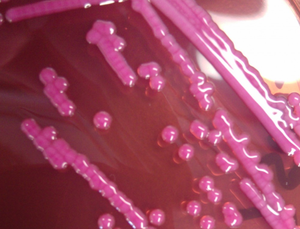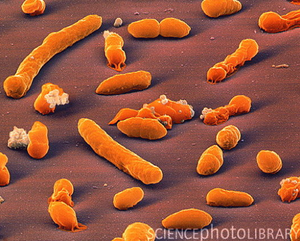Klebsiella oxytoca
A Microbial Biorealm page on the genus Klebsiella oxytoca
Classification
Higher order taxa
Bacteria; Proteobacteria; Gammaproteobacteria; Enterobacteriales; Enterobacteriaceae
Species
|
NCBI: Taxonomy |
Klebsiella oxytoca
Description and Significance

Klebsiella oxytoca is a gram-negative bacterium with a cylindrical rod shape measuring 2 µm by 5µm (8). In the 1950’s the strain M5aI was isolated with a notable characteristic of lacking a polysaccharide capsule. It was first named Aerobacter aerogenes and was later identified as K. pneumoniae, a strong pathogen that causes a form of Pneumoniae. It has recently been classified as K. oxytoca because it differs from K. pneumoniae in that it is indole-positive and able to grow on melezitose, but not 3-hydroxybutyrate (8).
Genome Structure
The genome for K. oxytoca has been sequenced in several strains. Virginia Bioinformatics Institute sequenced the genome for Klebsiella oxytoca KOX105 and determined the plasma length to be 0.0546Mbp with 0 chromosomes (15). The Genome Sequencing Center at Washington University in St. Louis sample sequenced Klebsiella oxytoca M5aI strain VJSK009 to -5.5X WGS coverage in plasmids and determined total genome length to be 5.28Mbp with 56% total GC content (16). The strain Klebsiella oxytoca KCTC1686 has been sequenced showing genome length of 5.97Mbp. Currently, 10 strains of Klebsiella oxytoca are being sequenced as part of the Human Microbiome Project.
Cell Structure and Metabolism
K. oxytoca are Gram negative bacteria with a bi-membrane structure. In addition to the plasma membrane, they have an outer membrane composed of lipopolysaccharides (LPS) that have O antigens. Between these two membranes lies a thin layer of peptidoglycan. The LPS layer has a polysaccharide chain known as Lipid A, which produces endotoxins that contribute to their pathogenicity (16). K. oxytoca is a facultative anaerobe (4) that can fix nitrogen (7) and hydrolyze cellulose (3). It is both catalase positive and indole positive (8). K. oxytoca produce β-lactamase, making them highly resistant to penicillin and ampicillin (4).

Ecology
K. oxytoca like other Klebsiella spp. can be found in a wide range of environments and are commonly referred to as ubiquitous and opportunistic in nature (8). K. oxytoca have been found in mammals and insects. In humans, this specie tends to colonize along the mucosa membranes of the colon and nasopharynx, and skin; however, they can be found colonizing on all parts of the body (2). Most infections of K. oxytoca are nosocomial, spreading via the hands of medical staff. Outbreaks occur in patients with immunodeficient diseases and patients whom are being treated with antibiotics. Outbreaks have also been reported occurring in both prenatal and neonatal infants (1).
Pathology
Species from the genus Klebsiella are frequently accountable for nosocomial infections in humans (8). They have the ability to colonize many different areas of the human body such as the skin, GI tract, sterile wounds, urine, and skin (5). While Klebsiella oxytoca does not cause as many of these infections as the more commonly known Klebsiella pneumonia, the genus Klebsiella was deemed responsible for 8% of all nonsocomial bacterial infections in the United States and Europe. Due to this incidence rate, Klebsiella spp. are considered one of the most significant infectious pathogens in the United States. The most common infections caused by Klebsiella spp. found in hospitals are as follows: urinary tract infections, pneumonia, wound infections, septicemia, neonatal septicemia, and nosocomial infections in ICU patients (8). Klebsiella oxytoca has increasingly been present in the blood samples of infants suffering from neonatal septicemia (11). Symptoms of neonatal septicemia include seizures, slow heart rate, temperature changes, jaundice, vomiting, diarrhea, low blood sugar, breaking difficulties, reduction in movements and sucking, and swollen abdomen (14).
Middle-aged men suffering with diseases such as alcoholism or diabetes are susceptible to Klebsiella spp. infections in the lungs. Such infections can lead to necrosis, hemorrhage, and inflammation of lung tissue resulting in bloody mucoid sputum, which is a common symptom (5). K. oxytoca is an opportunistic pathogen that can spread extremely quickly leading to nosocomial outbreaks. The gastrointestinal tract in hospital patients and hands of hospital staff are the two most common locations for the Klebsiella spp. to be found. Antibiotics, urinary catheters, invasive devices and contaminated respiratory equipment all increase the susceptibility of a person to a Klebsiella spp. infection (5).
Current Research
Raikher et al. (2010) analyzed the product obtained from the biomineralization of iron salt solutions by Klebsiella oxytoca. The resulting products, ferrihydrite nanoparticles, were determined to have magnetic properties that may be useful in the field of bioengineering and nanomedicine. K. oxytoca was previously known in geochemistry and industrial microbiology for mineralizing large amounts of iron in anaerobic conditions (9). In this study, K. oxytoca from a Russian lake was isolated from a sample of sapropel via a magnetic separator. After isolation, K. oxytocawas grown under microaerophilic and aerophilic conditions with varying light conditions in the presence of a yeast extract and ferric citrate. The resulting ferrihydrite nanoparticles magnetization curves were measured using a vibrating-coil magnetometer with a superconducting solenoid. These measurements resulted in a confirmation of the presences of two fractions of biogenic ferrihydrite. From the data gathered, it seemed the difference between the two fractions was magnetic susceptibility with the Fe12 particle having a higher susceptibility than the Fe34 (9). The magnetic susceptibility of these products results in a possibility of magnetic control being exerted over them.
Klebsiella oxytoca is known to breakdown cyanide, a chemical that is extremely toxic to humans. Wastewater that contains cyanide must be treated before it is released into the environment and the current methods of treating the water (e.g. alkaline chlorination and wet-air oxidation) are not only extremely expensive, but also, the reagents used in the process are hazardous. Tang et al. (2010) had previously shown that Klebisialla oxytoca was successful in degrading 1 mM cyanide into ammonia and recently they have looked into the molecular aspect of this (13). Electrophoresis and computer analysis were used to identify proteins. Some of the proteins were excised and further testing was perfromed to extract them and identify them using the NCBI database. The researchers identified 27 proteins that are known to be involved with carbohydrate, nucleotide, amino acid, and nitrogen metabolism, and oxidation-reduction reactions (13).
Cool Factor
Klebsiella oxytoca was determined to be the cause of spontaneous arthritis in the knee of a 30-month old child with no prior history of any bacterial infections (6). The child had not been hospitalized recently, was up to date on all vaccinations, and did not present with a urinary tract infection. Normally, cases of spontaneous arthritis in children are associated with Staphylococcus aureus, Kingella kingae, and Streptococcus pneumonia (6). The patient was treated with antibiotics specific to each of those bacteria, respectively, which ultimately proved to be ineffective. During this time no changes occurred in the patient’s symptoms. The bacteria present in the synovial fluid of the knee was finally identified as K. oxytaca, and the antibiotic regimen was adjusted accordingly. The antibiotics, ceftriaxone and amikacin, were used for two days, then switched solely to ceftriaxone due to the results from antimicrobial susceptibility testing (6). X-rays taken post-antibiotic treatment showed a complete recovery in the child's knee.
References
(1) Berkowitz, L.B., and Umeh, O. (2011). Klebsiella Infections. Medscape Reference.
(2) Charles River International Inc. Klebsiella species (K. oxytoca, K. pneumoniae). 2009.
(4) Haartmann. (2012). Bode Science Center: Klebsiella oxytoca (bacterium incl. ESBL); [accessed 2012 Feb 11. Available from: http://www.bode-science-center.com/center/relevant-pathogens-from-a-z/klebsiella-oxytoca.html]
(5) Medscape Reference (2011). Drugs, Diseases & Procedures: Klebsiella Infections; [accessed 2012 Feb 15. Available from: http://emedicine.medscape.com/article/219907-overview#a0104]
(10) The Retroscope. (2011). Klebsiella oxytoca Colony Retroscope; [modified 2011 March 16; accessed 2012 Feb 14. Available from: http://www.retroscope.eu/wordpress/klebsiella-oxytoca/kleboxcolony/]
(12) Science Photo Library Ltd. (2012). Science Photo Library: Klebsiella oxytoca bacteria; [accessed 2012 Feb 14. Available from: http://www.sciencephoto.com/media/11579/enlarge#]
(14) U.S. National Library of Medicine (2011). Medline Plus: Neonatal sepsis; [accessed 2012 Feb 15. Available from: http://www.nlm.nih.gov/medlineplus/ency/article/007303.htm]
(15) Virginia Bioinformatics Institute (2012). Pathosystems Resource Integration Center: Klebsiella oxytoca KOX105; [accessed 2012 Feb 1. Available from: http://patricbrc.vbi.vt.edu/portal/portal/patric/Genome?cType=genome&cId=163830]
(16) Washington University in St. Louis. (2011). The Genome Institute at Washington University: Klebsiella oxytoca M5aI; [modified 2005 Dec 6; accessed 2012 Feb 1. Available from: http://genome.wustl.edu/genomes/view/klebsiella_oxytoca_m5al]
Edited by students of Dr. Iris Keren:
NEU SPRING 2012 Andrea Punko, Brittany King, and Sean McBarron
